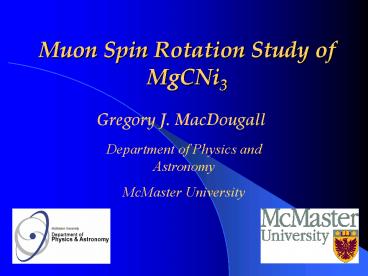Muon Spin Rotation Study of MgCNi3 - PowerPoint PPT Presentation
1 / 11
Title:
Muon Spin Rotation Study of MgCNi3
Description:
Muon Spin Rotation Study of MgCNi3. Gregory J. MacDougall. Department of Physics and Astronomy ... Andre Savici Columbia University. Peter Russo Columbia University ... – PowerPoint PPT presentation
Number of Views:156
Avg rating:3.0/5.0
Title: Muon Spin Rotation Study of MgCNi3
1
Muon Spin Rotation Study of MgCNi3
- Gregory J. MacDougall
Department of Physics and Astronomy McMaster
University
2
MgCNi3- The Material
- discovered at Princeton in 2001
- cubic perovskite structure with
- a?3.8Å
- variable C concentration
- electronic properties dominated
- by nickel 3d bands
- superconducting ground state!
3
MgCNi3- The Superconductor
Tc? 7-8K ? ? 40Å ? ? 2300Å ?type-II SC close
to FM instability pairing symmetry?
The fact that superconductivity rather than
ferromagnetism occurs in a compound where there
is so much nickel present is surprising,
and suggests that MgCNi3 is a candidate compound
for unconventional superconductivity.
He et al., Nature Vol. 411, 54 (2001).
4
Pairing Symmetry?
lack of single crystals preclude possibility of
doing phase sensitive measurements ?turn to
measurements which look for line nodes
Some models have tried to resolve apparent
disparity, but predict spontaneous time-reversal
symmetry breaking (TRSB) Voelker and Sigrist,
cond-mat/0208367 (2002).
5
Muon Spin Rotation (µSR)
Muons created 100 spin polarised (parity
violating weak decay).
Muon decay emits e preferentially in direction
of spin.
? Time histogram of decay positrons reflects
details of local magnetic field distribution.
6
Abrikosov Lineshape
By looking at the distribution of fields due to
a vortex lattice, transverse-field µSR (TF-µSR)
can get an absolute measure of the penetration
depth, ?.
7
The MgCNi3 Lineshape
TF-µSR lineshape indicative of vortex lattice
with additional background signal (20)
- Can roughly approximate decay envelope as
gaussian, - exp(-?2t2/2), where ?? ns/m ?1/?2.
- captures correct temperature dependence of ?.
- absolute value of ? requires numeric conversion.
8
Temperature Dependence of ?
?? ns/m??-2
Results
Tc7K
Functional form implies s-wave gap
9
Search for TRSB
The rate of muon depolarisation in zero-field
µSR (ZF-µSR) is a sensitive probe for
spontaneous internal magnetic fields.
0.1G
0.05G
Results
no spontaneous fields present greater than
0.03G above 2.5K
10
Conclusions
MgCNi3 shows a superconducting transition next
to a ferromagnetic instability which raises
questions about the SC mechanism TF-µSR
studies show lineshape indicative of Abrikosov
lattice Temperature dependence of lt?Bgt??-2
implies s-wave gap ZF-µSR studies put upper
limit of 0.03G on any possible spontaneous
internal magnetic fields above 2.5K
11
Acknowledgements
- Graeme Luke McMaster University
- Chris Wiebe McMaster University/Columbia
University - Tomo Uemura Columbia University
- Andre Savici Columbia University
- Peter Russo Columbia University
- Bob Cava Princeton University
- Natural Sciences and Engineering Research Council
of Canada






























![Top 5 Tennis Strings for Spin 2021 [Reviewed] PowerPoint PPT Presentation](https://s3.amazonaws.com/images.powershow.com/9683536.th0.jpg?_=202111150212)
